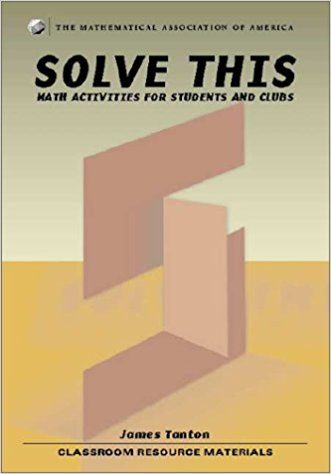After first hearing of James Tanton (the subject of our April 2017 interview), I was excited to discover that he had books in print. The first one I got was SOLVE THIS! Even though I was already a mathematics teacher and teacher-educator, I found many of the problems it offered challenging, some of them more than slightly so. Very few of them were familiar to me and many required thinking in areas of mathematics I knew little about, though that didn’t make them inaccessible or overly forbidding.
What grabbed my attention instantly, however, was the way in which Tanton structured the book. There were three main divisions. The first, “Activities and Problem Statements,” had 30 sections, each of which presented two to five related problems that introduced one main mathematical theme. Solving one problem in a section didn’t guarantee that the reader could automatically get the next one, but it seemed generally helpful to try them in order within a section. On the other hand, it was perfectly fine to skip a section if the problems were not of interest or seemed too difficult. Some themes recurred in later sections, but overall, each chapter could be tackled independently and out of sequence.
The second division, “Hints, Some Solutions, and Further Thoughts,” offered just that. For some problems, Tanton offered minimal hints that could help the would-be solver get a grip on a way to attack them. In a few cases, he gave a solution. But often, the solution was there only because those pesky “further thoughts” posed related, perhaps more challenging questions. Of course, for those familiar with how mathematicians think, this was a familiar approach of generalizing from a particular problem to something deeper and/or further reaching. Indeed, I thought I recognized the hand of George Polya and his book on heuristic approaches to mathematics, HOW TO SOLVE IT.
The last division, “Solutions and Discussions,” generally gave answers to problems from the first 30 chapters, as well as to those posed in those “further thoughts,” but there were also even FURTHER thoughts offered here, which is to say follow-up questions to some of the previous problems. And these were left for readers to ponder past the completion of the book. And this, too, was consistent with the teaching of Professor Polya, as well as with the philosophy of Ellen and Robert Kaplan, the Math Circle founders who first told me about James Tanton.
To be clear, SOLVE THIS! is a book for more than “math club” students. It should be of interest to both veteran recreational mathematics enthusiasts and novices, to students not yet in college, to those considering becoming mathematics majors, and to anyone who wants to learn something about how mathematicians often think about problems, what they do with them, and how almost any good problem leads not simply to answers but to more problems and questions.


Solve This was published by MAA as an e-book in 2001 and seems to be available for sale from them for $22.00 PDF and $38.00 print on demand:
https://www.maa.org/press/books/solve-this-math-activities-for-students-and-clubs. The above page includes a couple of sample chapters.
What is in the book solve than .